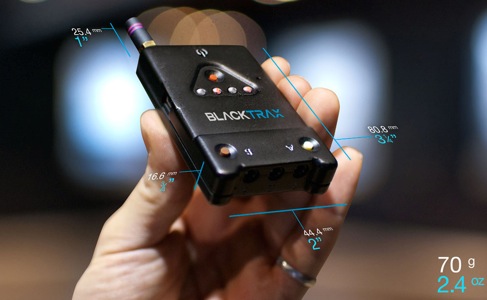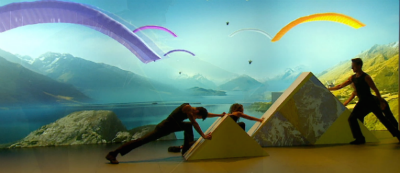BlackTrax for Mercedes Benz Launch

- CAST BlackTrax Ltd supplied the BlackTrax motion-tracking solution to multimedia production company m box bewegtbild GmbH for the press and dealer launch of the new Mercedes Benz V-Class 8-seater MPV. The world premiere took place on January 30, 2014 at the Olympiapark in Munich, Germany.
BlackTrax motion-tracking solution

Under the lead of Daimler's lead agency Oliver Schrott Kommunikation (OSK), m box was tasked with producing an 3:40 minute sequence that used a hybrid mix of live action and CG animation. Four full-HD edge-blended projectors fired CG content onto a 20m-wide rear-projection screen for the backdrop, while a further five full-HD projectors were used to fire moving images onto the stage, where a dance troupe of 10 live performers and 20 movable elements in the shape of cubes, pyramids and vertical panels effectively provided a constantly moving series of projection-mapped surfaces.
The team at m box worked closely with the show’s choreographer, Alex Burgos, to ensure that the video content, lighting effects and audio soundtrack were all programmed to synergize with the movement of the dancers and the moving objects, communicating the new vehicle’s key attributes in a way that was both visually impressive and constantly surprising to the invited audience.
Martin Retschitzegger, CEO at m box, explained: “We used BlackTrax to track the movement of the movable objects across the stage multi-dimensionally, with the data from the BlackTrax then being fed to our own V4 media servers so that the projected imagery followed both people and props automatically – regardless of how fast and how far they moved, and in what direction.”
To produce precise tracking data to downstream multimedia and projectors, CASTsupplied m box with 20 BTBeacons fixed to objects, along with ten of its PoE BTSensors (which are motion capture cameras secured on the overhead truss around the space) for tracking the BTBeacons. Each BTBeacon, which is smaller than a flip-phone, contains an IR LED, accelerometer, gyroscope, and tiny wireless radio. 3-D tracking data (x,y,z) is transmitted by a unique pulsing IR captured by the BTSensors, while orientation information in three dimensions (yaw, pitch roll) is sent by RF directly to the central BTController – making six dimensions of tracking in total – all in realtime. From these multiple sources, the BTServer determines the precise dynamic positional data and streams it downstream in DMX and/orArtNET.
“Using BlackTrax greatly enhances freedom of movement for the performers,” said Retschitzegger. “They don’t have to worry about hitting certain points on the stage or placing objects in exactly the right position at exactly the precise moment in time. With so many objects on stage at the same time, there is always a concern that they become a distraction for the performers. In this case, BlackTrax ensured that they were fun and became part of the show.
“Use of BlackTrax cuts down on rehearsal time because the dancers don’t have to precisely repeat their movements, so as well as creative freedom, your production saves time and money as well.
A daily selection of the top stories for AV integrators, resellers and consultants. Sign up below.
“BlackTrax is very easy to set up. The BTSensors are about the size of a webcam and once they have been hung strategically around the space, the whole system can becalibrated within minutes. Once the performers and modular pieces of staging have been tagged with BTBeacons, BlackTrax ‘reads’ the whole space and essentially becomes the ‘eye’ of the media server, allowing it to see and understand all the complex movements of people and objects that are taking place on-stage.”
Retschitzegger and his crew also received class-leading support from the BlackTrax Team, as he explained: “Using projection on to a moving stage and tracking objects in realtime was only possible in close co-operation with the expert and innovative BlackTrax Team, which wrote a custom protocol so that the BlackTrax Solution could ‘talk’ to our proprietary media server. After a first technical test run in the first week of January, potential problems were spotted and analyzed, and further adjustments made to guarantee a perfect show performance during theevent.
“Being able to design the effects in advance as usual but without the need to spend time plotting the path that performers could learn and repeat (which would be tracked and delivered in realtime by BlackTrax) freed us to be even more creative and spontaneous within the production, which is hard to achieve when you are working with such tight load-in and rehearsal times.
The AVNetwork staff are storytellers focused on the professional audiovisual and technology industry. Their mission is to keep readers up-to-date on the latest AV/IT industry and product news, emerging trends, and inspiring installations.
